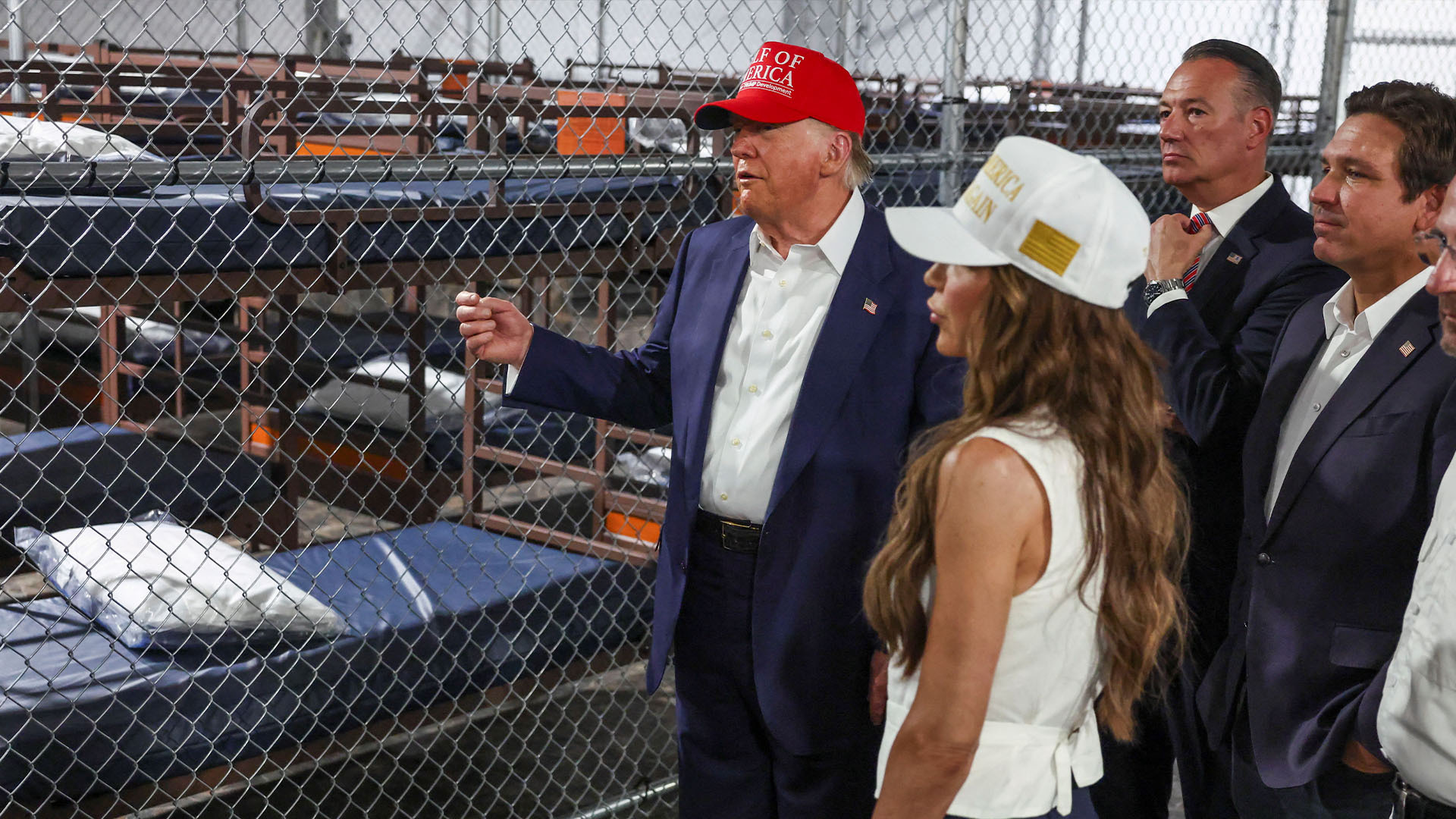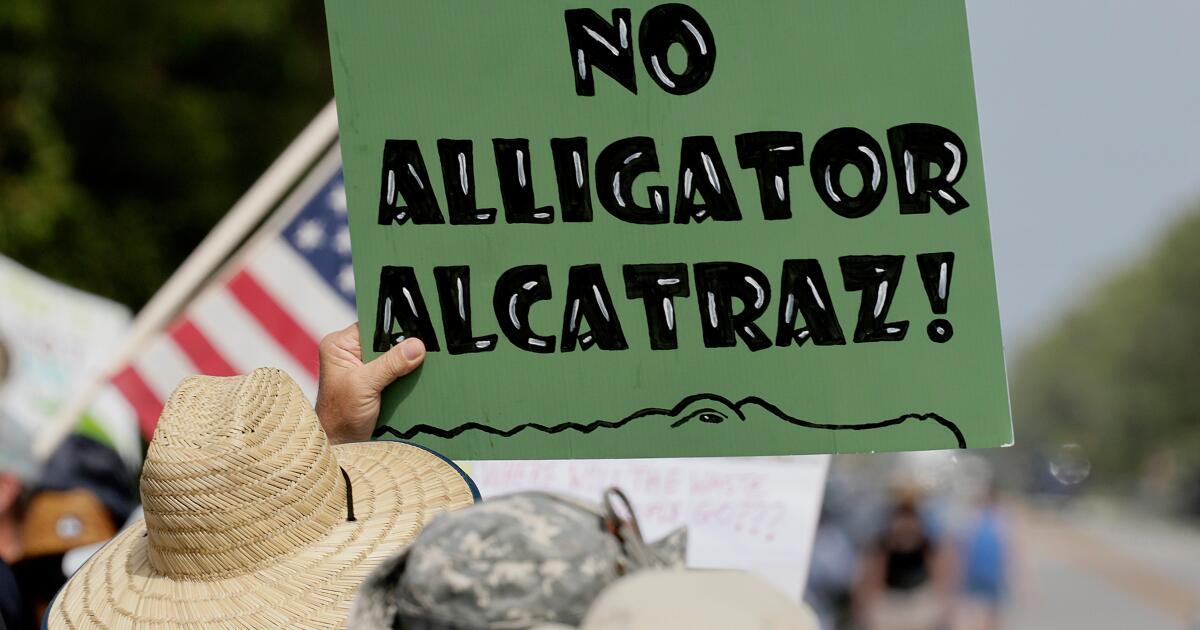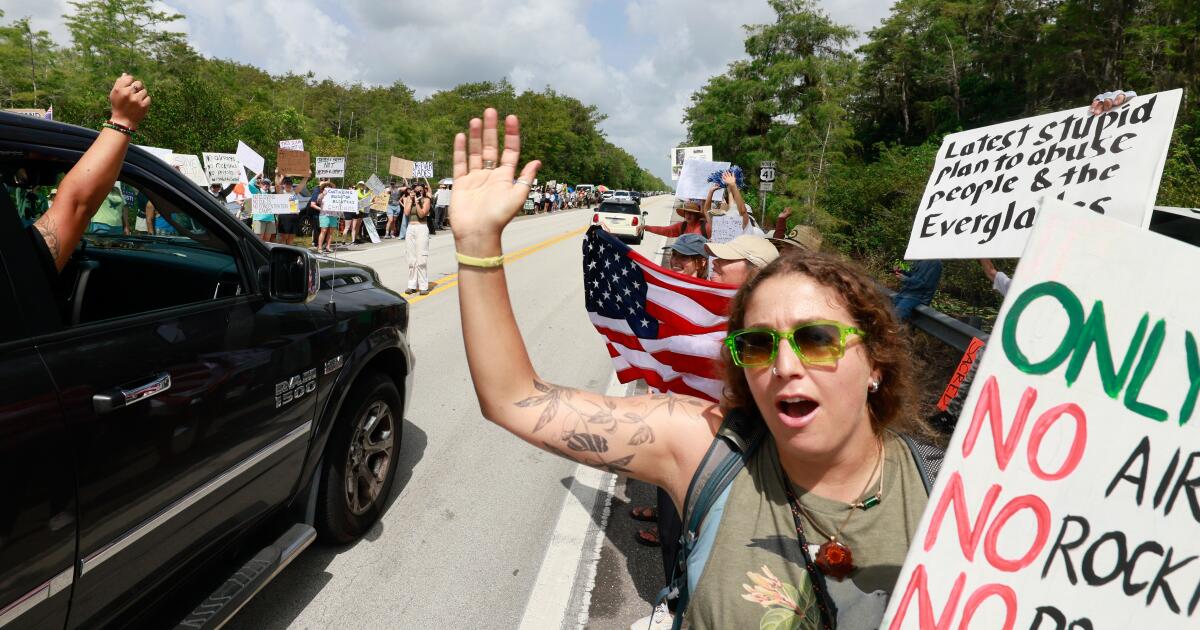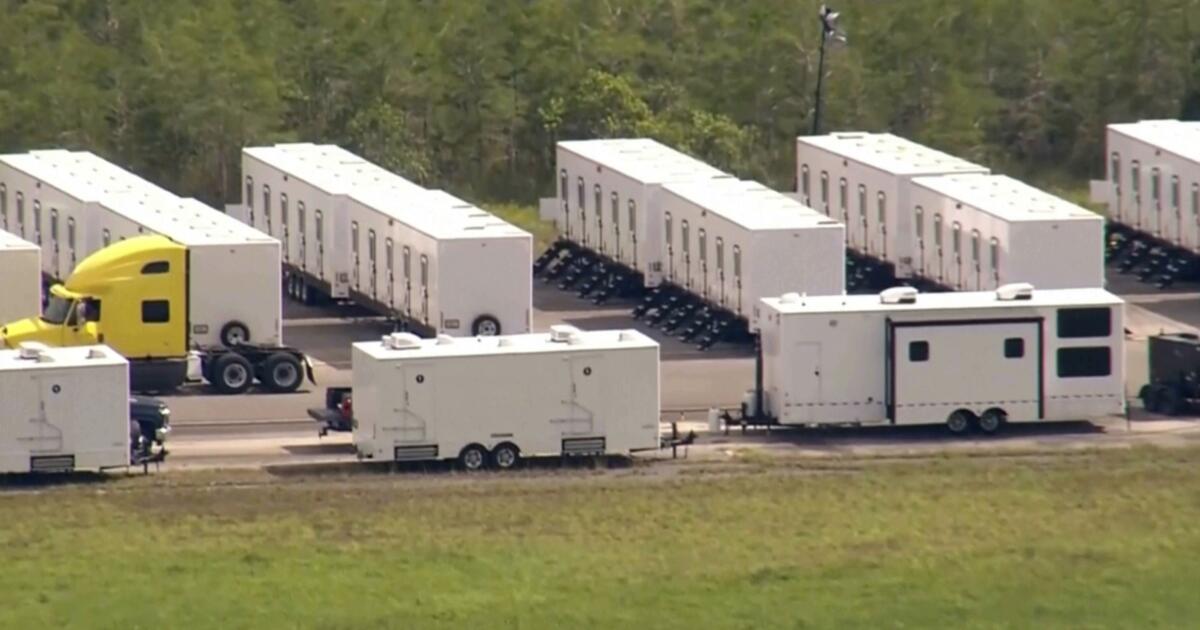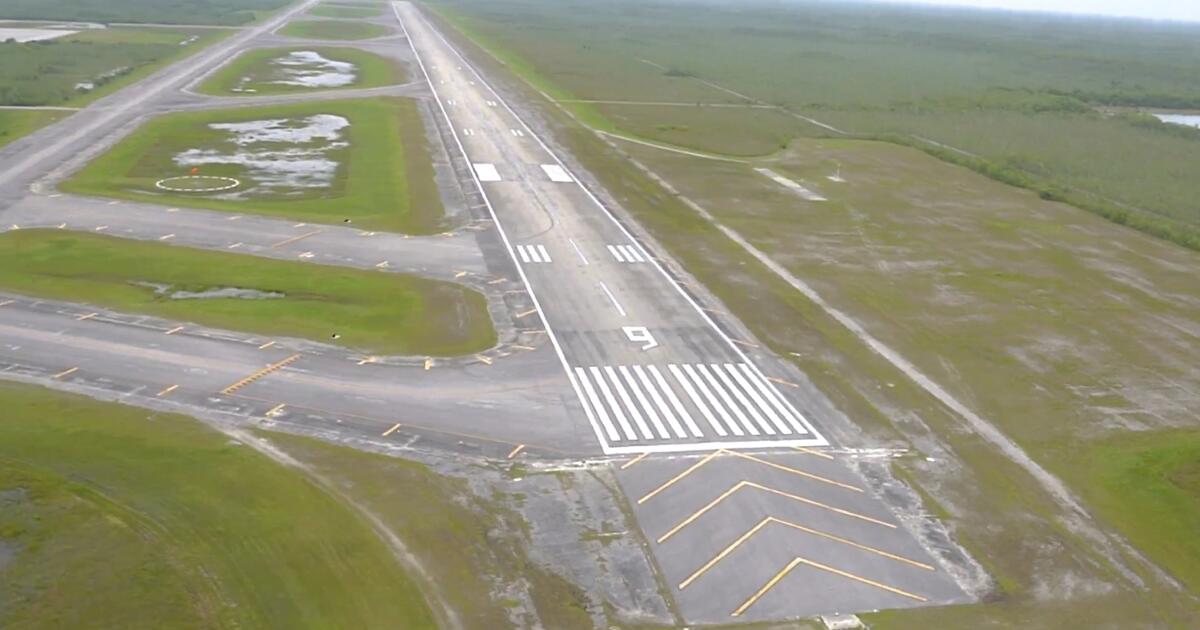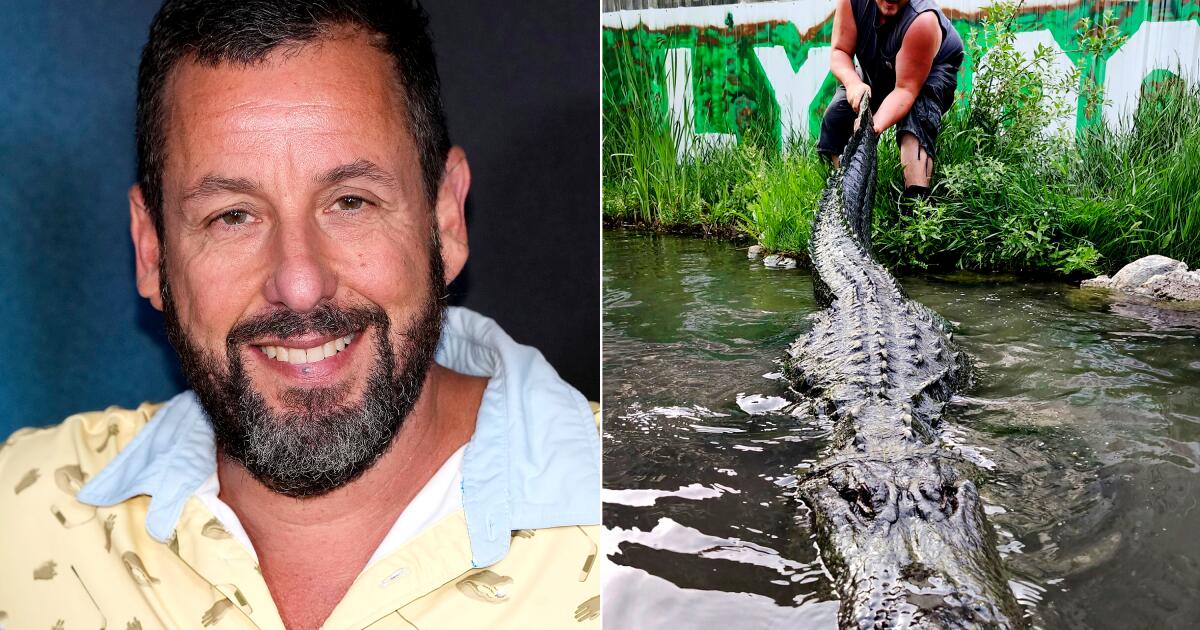‘Cops in the form of alligators’: Trump visits Florida’s Alligator Alcatraz | Donald Trump News
United States President Donald Trump has travelled to the southern tip of Florida to inaugurate a new immigration detention facility, nicknamed Alligator Alcatraz.
On Tuesday, Trump joined Florida Governor Ron DeSantis and Homeland Security Secretary Kristi Noem at the remote facility, located in a vast wetland region known as the Everglades.
“This is what you need,” Trump said. “A lot of bodyguards and a lot of cops in the form of alligators.”
The president then quipped about the dangers: “I wouldn’t want to run through the Everglades for long.”
The facility, built on the site of the former Dade-Collier Training and Transition Airport in Ochopee, is designed to help address the need for more beds and more space to carry out Trump’s campaign for mass deportation.
State Attorney General James Uthmeier first announced Florida’s “Alligator Alcatraz” two weeks ago, sharing a video on social media that featured bellowing alligators and pulsing rock music to underscore the forbidding nature of the facility.
“This 30-square-mile [78sq-km] area is completely surrounded by the Everglades. It presents an efficient, low-cost opportunity to build a temporary detention facility because you don’t need to invest that much in the perimeter,” Uthmeier said.
“If people get out, there’s not much waiting for them other than alligators and pythons. Nowhere to go. Nowhere to hide.”
Its nickname draws from the lore surrounding the Alcatraz federal prison, an isolated, maximum-security detention centre built on a rocky island in the middle of the San Francisco Bay in California. That facility, closed since 1963, gained a reputation for being unescapable — though there were, indeed, five escapees whose fates remain unknown.
“It might be as good as the real Alcatraz site,” Trump said of the Florida site on Tuesday. “That’s a spooky one too, isn’t it? That’s a tough site.”
Alcatraz has long been a source of fascination for Trump, who mused earlier this year about reopening the San Francisco facility, despite cost and feasibility concerns.
Similarly, the Alligator Alcatraz facility has spurred criticism for its human rights implications, its location in an environmentally sensitive landscape and its proximity to communities of Miccosukee and Seminole Indigenous peoples.
But the Trump administration has embraced its location as a selling point, as it seeks to take a hard-knuckled stance on immigration.
“There is only one road leading in, and the only way out is a one-way flight. It is isolated and surrounded by dangerous wildlife in unforgiving terrain,” White House press secretary Karoline Leavitt said on Monday.
“ This is an efficient and low-cost way to help carry out the largest mass deportation campaign in American history.”
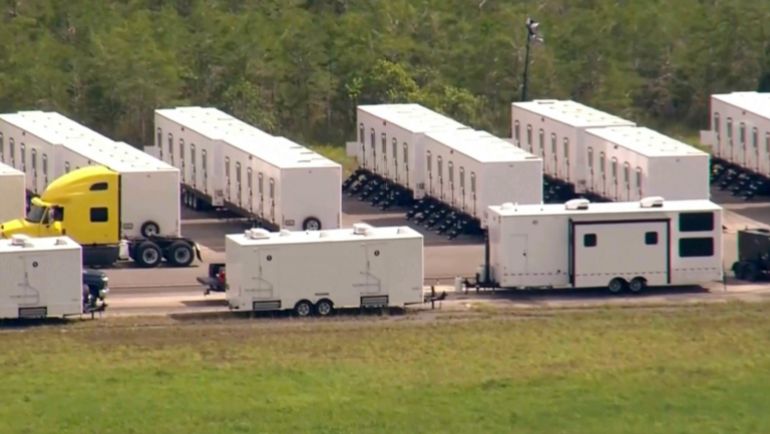
Dressed in a baseball cap that read, “Gulf of America: Yet another Trump development”, Trump flew to Ochopee to inspect the Alligator Alcatraz facility on its opening day.
Florida officials have celebrated the fact that it took only eight days to set up the detention centre, which appears to use temporary structures on the pavement of the former airport.
Governor DeSantis, who ran against Trump in 2024 for the Republican presidential nomination, said that Alligator Alcatraz would take advantage of the adjacent airstrip to facilitate expedited deportations for migrants.
“Say they already are been ordered to be deported,” DeSantis told reporters on Tuesday.
“You drive them 2,000 feet [667 metres] to the runway. And then they’re gone. It’s a one-stop shop, and this airport that’s been here for a long time is the perfectly secure location.”
The head of the Florida Division of Emergency Management, Kevin Guthrie, added that the facility will be equipped to hold up to 3,000 migrants — up from an initial estimate of 1,000 — with the potential for expanding the premises.
A further 2,000 people will be held at Camp Blanding, a National Guard base on the other side of the state, in northern Florida.
A poster on display at Trump’s news conference in Ochopee also advertised 1,000 staff members on site, more than 200 security cameras and 28,000 feet — or 8,500 metres — of barbed wire.
Guthrie sought to dispel concerns that the facility might be vulnerable to natural disasters like hurricanes. The Everglades, after all, collects overflow from nearby Lake Okeechobee and drains that water into the Florida Bay, making it a region prone to natural flooding.
“As with all state correctional facilities, we have a hurricane plan,” Guthrie said, pointing to the detention centre’s “fully aluminium-frame structure”.
He said it was capable of withstanding winds up to 110 miles per hour (177 kilometres per hour), equivalent to a Category 2 hurricane.
“All in all, sir,” Guthrie told Trump, “this has been a perfect state logistics exercise for this hurricane season.”
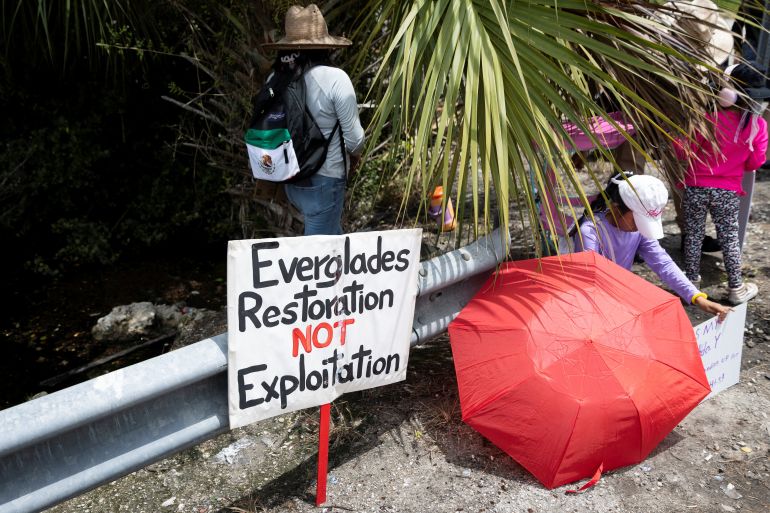
Still, human rights advocates and environmental groups gathered on the highway leading to Alligator Alcatraz on Tuesday to show their opposition to Trump and his deportation plans.
Protesters chanted through megaphones, “Hey hey, ho ho, Donald Trump has got to go.” Some picket signs read, “Communities not cages” and “We say no to Alligator Alcatraz!”
The American Civil Liberties Union (ACLU) of Florida released a statement prior to the facility’s opening, denouncing the Trump administration for conflating immigration with criminality.
The creation of Alligator Alcatraz, it said, was an extension of that mentality.
“The name ‘Alligator Alcatraz’ reflects an intent to treat people fleeing hardship and trying to build a better life for themselves and their families as dangerous criminals, which is both unnecessary and abusive,” the ACLU branch said.
Meanwhile, the Friends of the Everglades, an environmental group, called upon its supporters to contact Governor DeSantis to oppose the “massive detention center”. It noted that the construction of the airport itself had raised similar environmental concerns nearly 50 years earlier.
“Surrounded by Everglades National Park and Big Cypress National Preserve, this land is part of one of the most fragile ecosystems in the country,” the group said in a statement.
“The message is clear: No airports. No rock mines. No prisons. Only Everglades. Let’s not repeat the mistakes of the past. This land deserves lasting protection.”
Trump, however, argued in Tuesday’s news conference that the construction mostly built upon the existing airport.
“ I don’t think you’ve done anything to the Everglades,” he said, turning to Governor DeSantis. “I think you’re just enhancing it.”
DeSantis himself brushed aside the environmental criticisms as attempts to derail the president’s deportation initiative.
“ I don’t think those are valid and even good faith criticisms because it’s not going to impact the Everglades at all,” the governor said, promising no seepage into the surrounding ecosystem.
Trump hinted that the Alligator Alcatraz site could be the first of many similar, state-led immigration detention facilities.
“ I think we’d like to see them in many states — really, many states,” he said. “At some point, they might morph into a system where you’re gonna keep it for a long time.”

